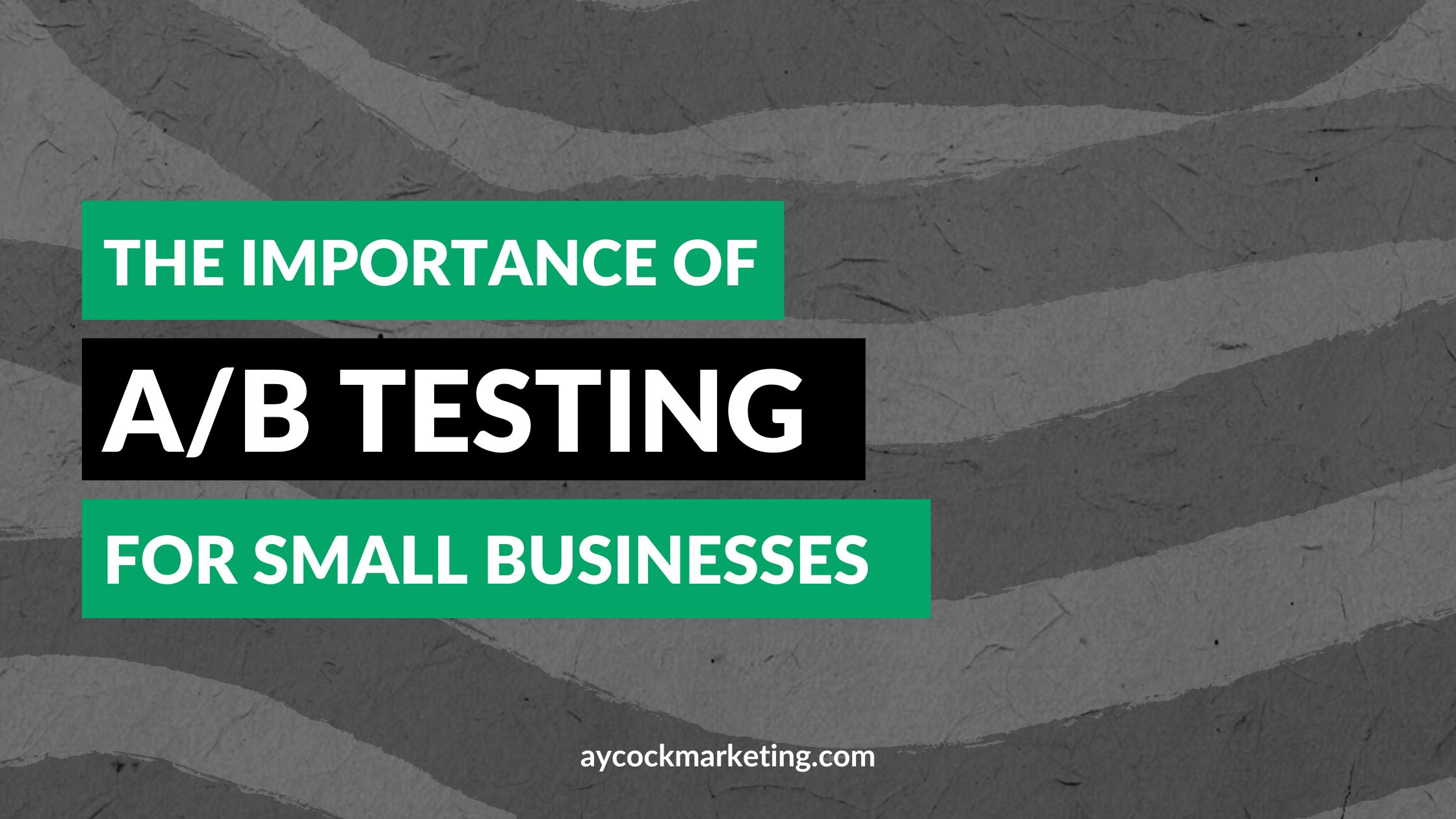A/B testing is a marketing technique to compare two versions of a web page or marketing campaign to determine which one performs better. By showing one version to a randomly selected group of users and the other version to another randomly selected group, small businesses can determine which version leads to more conversions, such as sign-ups or purchases.
A/B testing is a excellent tool for improving conversion rates because it allows small businesses to make data-driven decisions about their marketing strategies. Instead of relying on intuition or assumptions, A/B testing will enable businesses to test their ideas and hypotheses in a controlled environment and get concrete data about what works and what doesn’t.
The benefits of A/B testing for small businesses are numerous. By improving conversion rates, A/B testing can increase revenue and profits and enhance customer experience and loyalty. A/B testing can also help small enterprises to make better marketing strategies by providing concrete data about what works and what doesn’t. A/B Testing will lead to more effective campaigns, better targeting of customers, and a competitive advantage in the marketplace.
Understanding A/B Testing
As a small business owner in South Carolina, you may have heard of A/B testing. Still, you may not be thoroughly familiar with what it is and why it’s crucial. Let’s start by defining A/B testing.
Definition and Examples of A/B Testing
A/B testing compares two webpage versions, email, or another marketing asset to see which performs better. One version, called the control, is the original version. In contrast, the other, called the variant, has one or more changes that are being tested. Visitors are randomly split into two groups and shown either the control or the variant. The performance of each version is measured, and the one that performs better is chosen as the winner.
Examples of A/B testing include testing different headlines, calls to action, images, colors, and layouts. For instance, you may test two headlines on your website’s homepage to see which one gets more clicks or two different product images to see which generates more sales.
How A/B Testing Works
A/B testing works by dividing your audience into two groups and presenting each with a different version of your marketing asset. The performance of each version is measured using key performance indicators (KPIs) such as click-through rates, conversion rates, bounce rates, and revenue generated. The version that performs better is selected as the winner and implemented permanently.
Why A/B Testing is Important for Small Businesses
A/B testing is crucial for small businesses because it allows you to make data-driven decisions about your marketing strategies. By testing different versions of your website, emails, and other marketing assets, you can identify what works and what doesn’t and optimize your campaigns accordingly. This can lead to improved conversion rates, increased revenue and profits, and a better customer experience. Additionally, A/B testing can help you stay ahead of the competition by constantly improving and refining your marketing efforts.
Now that you understand what A/B testing is and why it’s essential, let’s explore the benefits of A/B testing for small businesses.
Benefits of A/B Testing
As a small business owner in South Carolina, you want to ensure that your marketing efforts are effective and yield the best results possible. A/B testing is a remarkable tool that can help you achieve that goal. Here are some of the exemplary benefits of A/B testing for small businesses:
Improved Conversion Rates
One of the most significant benefits of A/B testing is that it can help you improve your conversion rates. By testing different versions of your website, emails, and other marketing assets, you can identify what resonates best with your target audience and optimize your campaigns accordingly. This can result in higher conversion rates, which means more leads, sales, and revenue for your business.
Increased Revenue and Profits
Improved conversion rates also translate into increased revenue and profits for your business. By identifying the most effective marketing strategies, you can increase your sales and revenue without increasing your marketing spend. This means more money in your pocket and a more profitable business.
Enhanced Customer Experience and Loyalty
A/B testing can also help you enhance your customer experience and build loyalty. By testing different elements of your website or marketing materials, you can identify what your customers respond best to and create a more personalized experience. This can increase satisfaction and loyalty, translating into repeat business and positive word-of-mouth recommendations.
Better Decision Making and Marketing Strategies
A/B testing can also help you make better decisions about your marketing strategies. By using data and insights to inform your choices, you can be more confident that the changes you make will positively impact your business. Additionally, A/B testing can help you identify new opportunities for growth and optimization.
Competitive Advantage
Finally, A/B testing can give you a competitive advantage by helping you stay ahead of the curve. You can outperform your competitors and capture a larger market share by constantly testing and optimizing your marketing efforts.
Overall, the benefits of A/B testing for small businesses in South Carolina are clear. Implementing A/B testing in your marketing strategies can improve your conversion rates, increase your revenue and profits, enhance your customer experience and loyalty, make better decisions, and gain a competitive advantage.
How to Conduct A/B Testing
Now that you understand the benefits of A/B testing knowing how to conduct it effectively is essential. Here are the critical steps involved in conducting A/B testing:
Choosing the Right Elements to Test
The first step in A/B testing is to choose the correct elements to test. This could include anything from your website’s design and layout to your email subject lines and call-to-action buttons. To select the right features to test, think about your business goals and what changes you think might significantly impact your audience.
Creating Hypotheses and Setting Goals
Once you’ve chosen the elements to test, you must create hypotheses and set goals. Your hypotheses should be based on data and insights about your audience. They should outline what you expect to happen due to the changes you’re testing. Your goals should be specific and measurable, so you can track your progress and determine the success of your tests.
Designing and Implementing A/B Tests
Next, you need to design and implement your A/B tests. This involves creating different versions of the element you’re testing (for example, two different email subject lines) and randomly assigning them to different audience segments. You’ll need to ensure that the testing is conducted in a fair and unbiased way so that you can trust the results.
Collecting and Analyzing Data
Once your tests are live, you’ll need to collect and analyze data to determine which version of the element performed better. You can use tools like Google Analytics or A/B testing software to track your results and gather insights about your audience.
Interpreting Results and Making Data-Driven Decisions
Finally, you need to interpret the results of your tests and make data-driven decisions about optimizing your marketing efforts. This might involve changing your website, tweaking your email campaigns, or adjusting your social media strategy.
By following these steps, you can conduct effective A/B tests that help you improve your conversion rates, increase your revenue and profits, and stay ahead of the competition.
Common A/B Testing Mistakes to Avoid
While A/B testing can be a powerful tool for improving conversion rates and growing your business, there are some common mistakes that small business owners should be aware of. Here are some common A/B testing mistakes to avoid:
Testing Too Many Variables at Once
One of the most common mistakes in A/B testing is testing too many variables simultaneously. When you push too many variables, it’s challenging to determine which changes had the most significant impact on your results. Instead, try focusing on testing one variable at a time, so you can be confident about which changes are driving the improvements.
Not Testing for Long Enough
Another common mistake is not testing for long enough. A/B testing requires time to generate statistically significant results, so giving your tests enough time to run is essential. Failing to test for long enough can lead to inaccurate or inconclusive results. It may cause you to miss opportunities to improve your conversion rates.
Failing to Consider External Factors
External factors can significantly impact your A/B test results, so it’s essential to consider them when analyzing your data. For example, changes in seasonality or external events can affect your audience’s behavior and skew your results. It’s essential to control for external factors as much as possible and to keep them in mind when interpreting your results.
Not Segmenting Your Audience Properly
Segmenting your audience is an integral part of A/B testing. It allows you to test different versions of your content on different groups of people. Suppose you don’t segment your audience correctly. In that case, you may end up with misleading results that don’t accurately reflect the behavior of your target audience. To avoid this mistake, make sure you’re segmenting your audience based on relevant demographics or behaviors to get a more accurate picture of your tests’ performance.
Not Having a Clear Hypothesis or Goal
Finally, not having a clear hypothesis or goal is another common mistake in A/B testing. Without a clear hypothesis or purpose, knowing what you’re trying to achieve or what changes you should be testing is challenging. To maximize your efforts, make sure you have a clear hypothesis about what you expect to happen as a result of your tests and set specific, measurable goals so you can track your progress and determine the success of your tests.
By avoiding these common A/B testing mistakes, you can conduct more effective tests that help you improve your conversion rates and grow your business.
Our Final Thoughts
A/B testing is a powerful tool that small businesses can use to improve their conversion rates and grow their businesses. By testing different versions of their content and analyzing the results, small business owners can gain valuable insights into what works and what doesn’t and make data-driven decisions that lead to better marketing strategies and increased revenue.
We’ve now discussed the definition and benefits of A/B testing, how to conduct effective A/B tests, and common mistakes to avoid. We hope this information has helped help you understand the importance of A/B testing for your small business.
We encourage small business owners in South Carolina to implement A/B testing in their marketing strategies and to start small by testing one variable at a time. By doing so, you can gain valuable insights into what works and what doesn’t and make data-driven decisions that lead to better marketing strategies and increased revenue.
Remember, A/B testing is an ongoing process that takes time to see significant results. But by being patient and persistent, you can reap the rewards of this powerful marketing tool and take your small business to the next level.




